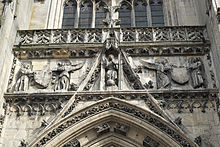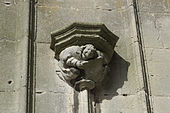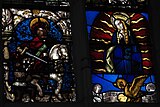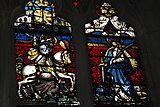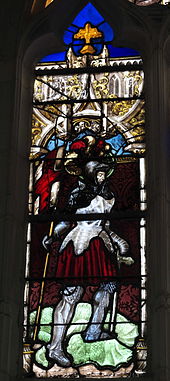St-Nicolas (Saint-Nicolas-de-Port)
The Catholic parish and Sanctuary of Saint-Nicolas in Saint-Nicolas-de-Port , a town in Meurthe-et-Moselle in the French region of Lorraine , started at the end of the 15th century and completed in the mid-16th century. It is dedicated to St. Nicholas of Myra and is considered the largest and last church in France to be built in the Flamboyant Gothic style. Numerous stained glass windows from the 16th century have been preserved in the church. In 1840 the church was added to the list of architectural monuments in France as a monument historique . Pope Pius XII elevated the church to a minor basilica in 1950 . To this day, a procession in honor of St. Nicholas takes place in the church every December.
history
In 1098 a relic of St. Nicholas, the Bishop of Myra, was brought from his tomb in the Italian city of Bari to Port and there kept in a chapel dedicated to Notre-Dame . In Port there was a ford over the Meurthe , which the Gorze Abbey controlled. The first pilgrimage church was consecrated as early as 1101 and placed under the patronage of St. Nicholas. It was replaced by a larger church in 1193.
Pilgrimages and masses drew pilgrims and merchants from all over Europe to Port and established the city's wealth. After his victory in the Battle of Nancy in 1477 over Charles the Bold , the last Duke of Burgundy , the Lorraine Duke René II supported the building of a new church. In gratitude for his victory, he declared St. Nicholas the patron saint of Lorraine. In 1495 the foundation stone was laid for the Grande Église (large church), which was to become the Lorraine national shrine. The choir and transept were completed before 1510, and the nave a few years later . The two towers were erected until 1544 and were covered with lead domes around 1560.
In 1635, during the Thirty Years War , the church was looted and set on fire. Part of the leaded glass window was lost. From 1847 to 1855 the windows were restored, some of which were supplemented and reassembled.
architecture
Exterior construction
Two domed towers, 87 and 85 meters high, rise from the west facade. The tower pillar of the multi-tiered, pointed arched main portal is covered with a sculpture of St. Nicholas, at whose feet the salt barrel with the three scholars brought back to life can be seen. The numerous niches on the facade and on the archivolts do not contain any figures, and they were probably never made. Only the canopies decorated with crabs and the consoles carved with animals and grotesque people under the pedestals are present. All three portals, like the tracery windows and the rose window, are covered by eyelashes . Crab friezes and tracery friezes above the main portal frame a figure of Christ, two angels to the side hold coats of arms in their hands.
Slender buttress arches on the outer walls direct the thrust of the vault onto the buttresses , which are crowned by high pinnacles . At the base of the roof there are well-projecting, figurative gargoyles . In the Rue des Fonts you can still see the merchants' sales rooms cut into the outer wall of the church.
inner space
The church consists of a three-aisled nave, a two- bay transept that does not protrude over the nave and a choir with a five-eighth end and two side apses . Three lancet windows with two lanes that extend to the vault illuminate the choir.
The main nave is two-story. Large ceilings windows have been cut over the high pointed arcades that open to the side aisles . A Triforium does not exist. The nave and transept are covered by a star vault supported by towering columns without capitals . Only narrow, decorative rings mark the transition where the vault ribs merge with the columns.
The north and south facades of the transept are broken up by two large four-lane windows, the top of which is a rose window. The south arm of the transept has a special column that is twisted in its upper part.
Murals
In the church, wall paintings that date to the early 16th century have been exposed again. Most of the paintings are attached to the pillars. You put u. a. St. Ivo , St. Martin sharing his cloak with a beggar, and St. Apronia, sister of St. Aper (Epvre), the bishop of Toul . One scene shows Mary with the baby Jesus , surrounded by John the Baptist , the Apostle John and St. Desiderius , the first bishop of Langres , who carries his head in his hand. Another scene shows Mary Magdalene being lifted into heaven by angels against the background of the Basilica Sainte-Marie-Madeleine in Saint-Maximin-la-Sainte-Baume in Provence . Another painting depicts a Descent from the Cross .
Leaded glass window
Several workshops were involved in the manufacture of the leaded glass windows . From a workshop in Lorraine, whose name has not been passed down, over thirty panes were created between 1508 and 1510, including the window (105) in the north apse with the depiction of St. Sebastian and the beheading of St. Barbara . The Lorraine Duke René II commissioned the then recognized glass painter Nicolas Droguet from Lyon , who worked in Saint-Nicolas-de-Port until 1510, for the three large choir windows . Mention is also made of a workshop in Troyes and a glass painter by the name of Jacot, who has preserved leaded glass windows in the Saint-Étienne cathedral and the Saint-Gengoult collegiate church in Toul . Most of the windows were made by Valentin Bousch from Strasbourg , who between 1514 and 1520 ran an important workshop with several employees in Saint-Nicolas-de-Port. From him u. a. the window (111) with the representation of the transfiguration of Christ and the lower scenes with the martyrdom of St. Sebastian created the window (113) in the north aisle of the choir. The upper scenes of this window with the depiction of the Adoration of the Magi are attributed to the prestigious Nuremberg workshop of Veit Hirschvogel , who also made many stained glass windows based on designs by Albrecht Dürer . The cardboard boxes for the window of the Saint-Nicolas basilica were created around 1508/10 by the painter and collaborator of Dürer Hans Süß von Kulmbach .
- Window (24) of the second chapel in the south aisle

Saint Honorius of Amiens
|
The two figures in this window were probably made in a workshop in Lorraine around 1518. They depict St. Honorius of Amiens , the patron saint of bakers, and a bishop. |
- Window (22) of the second chapel in the south aisle

Saint Claudius of Condat
The figure of the bishop was executed by Valentin Bousch. It was given the name tag Saint Claude in the 19th century and interpreted as Saint Claudius of Condat . |
- Window (20) of the third chapel in the south aisle
The angels in the tracery are attributed by the glass painter Jacot, who works in Toul, as well as the Madonna in the halo and the three scenes on the left depicting the fleece of Gideon , the blooming staff of Aaron and the vision of the prophet Ezekiel . The other panels depicting St. George, St. Martin sharing his cloak with a beggar, and St. Catherine were created by Valentin Bousch between 1514 and 1520 .
- Window (18) of the third chapel in the south aisle
|
In the tracery of the window God the Father and three angels are depicted. The discs were created by Jacot between 1510 and 1520. The figure of St. George is attributed to Valentin Bousch. |

- Window (9) of the first chapel in the north aisle
The figure of Emperor Heinrich II was probably created in Nuremberg around 1510. Henry II is shown with a model of a church.
- Window (19) of the fourth chapel in the north aisle
|
The Annunciation group on the two left panes was made by a Lorraine workshop around 1510. On the right lancet, St. Barbara is shown with her attributes , the sword and the tower. |
- Window (25) of the second chapel in the north aisle
|
The year 1544 can be read on the grisaille window. It was probably commissioned by the merchant Hanus Bermand for his Hôtel particulier and was not installed in the church until after 1635. On the two outer lower panes the client is shown with his children and his wife. In the upper scenes, Roman women are embedded in an architectural setting in the Renaissance style. |
Furnishing
- The sculptures of St. Roch , St. Sebastian, St. Stephen and a Pietà date from the 16th and 17th centuries .
- The altar of the baptistery dates from around 1515. Jesus and the twelve apostles are depicted on the altarpiece.
- The figure of a Madonna and Child, Notre-Dame de Port, is dated to the 13th century
literature
- Michel Hérold: Découvrir la basilique de Saint-Nicolas-de-Port . Connaissance et Renaissance de la Basilique, Saint-Nicolas-de-Port 2008, ISBN 2-9525452-2-7 .
- Michel Hérold: Les vitraux de la basilique de Saint-Nicolas-de-Port . Connaissance et Renaissance de la Basilique, Saint-Nicolas-de-Port 1996.
Web links
- Basilique Saint-Nicolas in the Base Mérimée of the French Ministry of Culture (French)
- Pietà from the 16th century in the Base Palissy of the French Ministry of Culture (French)
- Basilique Saint-Nicolas Parish Saint-Nicolas (accessed May 1, 2015)
Coordinates: 48 ° 37 ′ 54.1 ″ N , 6 ° 18 ′ 14 ″ E


